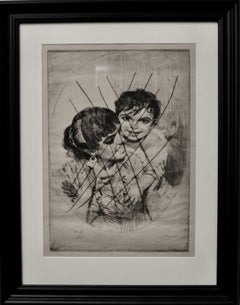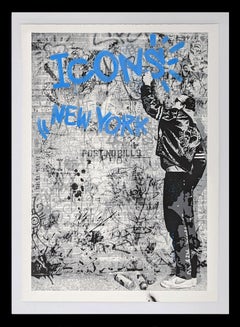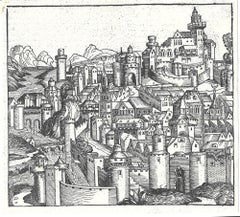Lundgrens Antiques Prints and Multiples
to
1
Overall Width
to
Overall Height
to
1
1
1
1
1
1
1
1
1
1
Mothers Joy III, also called Maternal Delight III
By Anders Zorn
Located in Stockholm, SE
Maternal Delight III, or Mothers Joy III, (In Swedish Modersglädje III) by Anders Zorn depicting a young woman lovingly playing with her child. A small amusing detail is the small child face visible on the lower left side, just outside the oval. This is an extremely rare etching and is one of two or possibly three known in existence of a so called cancellation proof. A cancellation proof etching of the Maternal Delight III is in the Boston Public Library Collection, USA.
Signed Zorn in the plate. When Zorn decided that the vey limited number of prints were all done he took his burin, (the steel cutting tool used in engraving also, back in history, called graver), and made cross hatched lines across the figures on the original plate, after which he made a couple of after proofs or cancellation proofs and the present etching is one of them. This gives the present work a special and interesting image of one of Zorns best and rarest etchings. Created in London 1883, the first year he made etchings.
Etching 276 x 406mm
Sheet circa 33,5 x 48cm
Literature
Asplund 6. Delteil. 5. Hjert & Hjert 6. Lidbeck 6.
Unfortunately some reflexes in the photos.
Anders Zorn (1860-1920) was a Swedish artist who attained international success as a painter, sculptor, and etching artist. He was to become one of Swedens foremost artists ever. No technique was foreign to him, he worked equally well with watercolors, wash technique or oil painting. The etching technique also attracted this virtuoso and the etchings contributed greatly to his success.
Between 1875 to 1880, Zorn studied at the Royal Swedish Academy of Arts in Stockholm, where he amazed his teachers with his talent. Members of the Stockholm Society approached him with commissions. In early 1881, Zorn met Emma Lamm, whose background was quite different from his. Emma Lamm was from a wealthy Jewish merchant family. She was interested in art and culture and, after a long engagement, they were married in 1885.
During the 1880s Zorn traveled extensively, to London, Paris, the Balkans, Spain, Italy, and the United States. In the 1890s when he was in Paris, he spent much time with Albert Edelfelt. He quickly became an international success and one of the most highly regarded painters of his era. In the beginning of Zorns career, it was primarily his skill as a portrait painter that gained him international acclaim, based principally upon his incisive ability to depict the individual character of his model, he came to portray many great people including three American Presidents: Grover Cleveland, William H. Taft, and Theodore Roosevelt.
Zorn also depicted Swedish dignitaries, for example King Oscar II in 1898, King Gustaf V in 1909, Queen Sophia in 1909, Prince Eugen in 1891, fellow artist Carl Larsson in 1897 and August Strindberg in 1910.
In the late 1880s, Zorn began working in the genre that is probably his hallmark for the general public, nude studies in the open air. Zorn had long been fascinated by the movements of water and the reflections of light on the water surface. Now Zorn chose to place a nude model by or in the water, with the aim of depicting people in nature.
When Zorn started the art of etching, he developed a technique with Rembrandt as a model, where he built up the motif with bursts of lines. The first etching was created in London in 1883, the same year as our Maternal Delight. Axel Herman Hägg, then active in London, was Zorn's teacher in this special technique. Hägg was the person Zorn depicted in his first etching. Zorn quickly mastered the etching technique itself and a unanimous art expert was able to conclude early on that Rembrandt had now found his equal.
At the age of 29, he was made a Chevalier de la Légion d'honneur at the Exposition Universelle 1889 Paris World Fair.
Zorn's reputation as an etcher spread across the world. Soon he could find his etchings in the major world metropolises in Europe and the USA. Zorn produced 289 different etchings, including portraits, genre studies and nude studies.
The motifs on Anders Zorn's graphic sheets are most often based on his own paintings, as ours, which is based on a watercolor he made in 1882 on his first trip to Spain. Even during Zorn's lifetime, his etchings were considered to be artistically superior to his paintings. As a result, his graphics quickly became sought after on the international art market. He was compared to Rembrandt, who as mentioned earlier was Zorn's great role model in the art of etching. Zorn was able to combine the old technique with his personal form of impressionism and the temporary and everyday with the universal. On the printing plates, one can study his outstanding etching technique, his characteristic play with parallel lines drawn in different directions, with varying degrees of force and intensity.
Zorn's art made him wealthy and he was thus able to build up a considerable collection of art. In their joint will, Anders and Emma Zorn donated their entire holdings to the Swedish State.
Some of his most important works can be seen at the National Museum of Fine Arts in Stockholm. Other museums holding major works by Zorn include the Musée d'Orsay in Paris, the Metropolitan Museum of Art in New York, and the Museum of Fine Arts, Boston. The Zorn Collections located in Mora and Garberg, Älvdalen, consist of four museums dedicated to the life and works of Anders Zorn. Shown there are extensive works of Zorn and his collected art.
The Bellman Prize (Bellmanpriset) is a literature prize for "an outstanding Swedish poet", every year awarded by the Swedish Academy. The prize was established by Anders Zorn and his wife Emma in 1920.
The motif: The present etching is based on a central and important work from Zorns first important trip to Spain, 1881-1882. After visiting Madrid and Seville, Zorn set off for Cádiz, tempted by the sea and the city’s women who were reputed to be the most beautiful in all of Spain.
In Maternal Delight, also translated to Mothers Joy and Mothers Pride...
Category
1880s Other Art Style Portrait Prints
Materials
Paper
Related Items
THE WALL BLUE (KEITH HARING)
By Mr. Brainwash
Located in Aventura, FL
Screen print and spray paint on hand torn archival art paper. Hand signed and numbered on front, thumb print on verso by the artist. Edition 19/75. Artwork size 30 x 22 inches. F...
Category
Early 2000s Street Art Figurative Prints
Materials
Paper, Screen
Tolosa (Toulouse); Leaf LXXI from Hartmann Schedel's Nuremberg Chronicle
Located in Middletown, NY
Woodcut on laid paper, 8 3/8 x 9 1/8 inches (212 x 233 mm), the full sheet. In excellent condition with text and portraits of Empedocles, Sapho, Zeuxis and others on the verso, as is...
Category
15th Century and Earlier Old Masters Figurative Prints
Materials
Ink, Handmade Paper, Laid Paper, Woodcut
Mars driven away from Peace and Abundance by Minerva
By Agostino Carracci
Located in Middletown, NY
Agostino CARRACCI, after Jacopo TINTORETTO
Sapientia Martem depellente Pax et Abundantia cogaudent; Mars driven away from Peace and Abundance by Minerva
Engraving on handmade laid ...
Category
16th Century Old Masters Figurative Prints
Materials
Ink, Handmade Paper, Laid Paper, Woodcut
Lidded Jar with Design of a Lotus Pond (hand signed shaped lithograph)
By Takashi Murakami
Located in Aventura, FL
Offset lithograph in colors on shaped wove paper. Hand signed lower right by Takashi Murakami. Hand numbered 81/300 lower right. Artwork size: 24.6 x 22.2 inches. Frame size: 30 ...
Category
2010s Contemporary Portrait Prints
Materials
Paper, Lithograph, Offset
$1,875 Sale Price
25% Off
H 30 in W 28 in D 1 in
Sam Colburn Carmel Artist Portrait, Signed Limited Edition Realist Lithograph
By Jack Coughlin 1
Located in Soquel, CA
Highly detailed and realistic portrait lithograph of the modernist watercolor artist Sam Colburn (American, 1909-1993) by Jack Coughlin (American, b. 193...
Category
1980s Realist Portrait Prints
Materials
Paper, Ink, Lithograph
$656 Sale Price
25% Off
H 14 in W 12 in D 0.25 in
婦女人相十品Fujo Ninso-Authentic Woodblock print-Popen o Fuku Musume-JapanesePublisher
Located in London, GB
-In light of new tariffs, we’ve applied a 20% discount off the market price of this piece to support our collectors in facing potential added costs. At the gallery, we work closely w...
Category
1990s Edo More Prints
Materials
Woodcut, Washi Paper, Ink
$677
H 15.67 in W 10.44 in D 0.04 in
Female Figure Underwater Realist Etching --"Separation" by Carol Bennett
By Carol Bennett
Located in Soquel, CA
Female Figure Underwater Realist Etching --"Separation" by Carol Bennett
Unique etching of a female figure submersed beneath the surface of water by California and Hawaii artist Ca...
Category
1990s American Impressionist Figurative Prints
Materials
Etching, Laid Paper
$972 Sale Price
20% Off
H 19 in W 24 in D 1 in
Marx Brothers "Animal Crackers" Movie Comedy Groucho, Harpo, Chico, Zeppo
By Albert Al Hirschfeld
Located in New York, NY
Marx Brothers "Animal Crackers" Movie Comedy Groucho, Harpo, Chico, Zeppo Caricature
Al Hirschfeld (1903-2003)
Marx Brothers in "Animal Crackers"
Sight: 12 x 15 1/2 inches
Paper Si...
Category
1970s Performance Figurative Prints
Materials
Paper, Etching
"Study 8" Figurative Lithograph
By Jim Smyth
Located in Soquel, CA
Lithograph of a figure of a woman by Jim Smyth (American, b. 1938). Numbered, titled, signed and dated "3/12", "Study 8", "Smyth 74” along the bottom edge. Unframed.
Jim Smyth has studied at the Academia de Belle Arti in Fiorenza, Italy, Ecole des BeauxArts in Geneva, New York Academy, and the Art Students League. He is also a graduate of UC Berkeley with a degree in Fine Art.
Although academically trained, Smyth practices and teaches a more impressionistic style of painting, focusing on the Alla Prima technique.
He is particularly knowledgeable about drawing, perspective, color theory and the human figure, his passion. Smyth, with extensive academic knowledge, has a profound love of all human representations as illustrated by his humorous quick sketches from life. He also practices and teaches oil painting and pastels.
When not in Provence, or Southeastern France, Smyth teaches intensely in art schools, art centers and several colleges in the Bay Area. He is a beloved instructor and his classes fill in quickly as he is very knowledgeable.
On his return to the United States, he began studying with Mr. Alanson Appleton at the College of San Mateo, San Mateo, California. Smyth was a founding member of the Appletree Etchers, Inc., an etching print shop organized by Mr. Appleton and his students to develop and promote color intaglio. Smyth served as Master Printer at the studio for many years perfecting the techniques of intaglio and developing the color theories of Mr. Appleton as applied to the deeply etched plate.
Smyth received his degree from the University of California, Berkeley, in 1972 and holds the California Community College Certificate and an Adult Education Certificate. Smyth was invited to teach "Anatomy for Artists" at Foothill College, Los Altos Hills, California, as a result of his many years of dissection of the cadaver and developed the course of study of Perspective for the college. During this period, he began teaching Life Drawing at the Pacific Art League of Palo Alto, Palo Alto, California. During the following thirty years Smyth has taught an average of twelve classes per week at the Pacific Art League of Palo Alto, the Palo Alto Art Center and the Burlingame Recreation Department among others in all phases of drawing and painting. He has conducted many workshops for the California Academy of Painters in many aspects of drawing and painting. Currently, he is an Adjunct Professor of Drawing at the College of San Mateo, San Mateo, California. He is an authority on the materials of painting and drawing, techniques of traditional drawing and painting, color theory, perspective and anatomy for artists. In his career in Life Drawing, Smyth has made over two hundred thousand drawings from the model.
In addition to studies at Berkeley, Smyth has studied at the College of San Mateo, Foothill College, De Anza College, Mission College, and West Valley College, all in California. One of the pivotal points in his career was studying with Mr. Maynard Dixon Stewart at the University of San Jose, California. He spent a year at the New York Academy of Art where he was offered a full scholarship and at the Art Students League of New York. He concurrently attended classes at the National Academy of Design in New York. Among others, Smyth studied with M. Andrejivec, Ted Schmidt, Elliot Goldfinger, Gary Fagin, Ted Jacobs, Leo Neufeld, David Leffel, Jack Ferragasso, Jim Childs and Everett Raymond Kinstler and Kim English. Smyth has also studied with the noted painter and colorist, Ovanes Berberian...
Category
1970s American Impressionist Figurative Prints
Materials
Paper, Etching
IMAGINE YOU ARE DRIVING (FAST) JACQUES
By Julian Opie
Located in Aventura, FL
Lambda print in colors, on Fuji color photographic paper dry-mounted to PVC (as issued). Hand signed and numbered in black marker on the reverse. Edition of 34/50. Published by Ala...
Category
Early 2000s Contemporary Figurative Prints
Materials
PVC, Photographic Paper, Lambda
Le Mannequin - Original PhotoLithograph by Jean Cocteau - Mid-20th Century
By Jean Cocteau
Located in Roma, IT
Le Mannequin is an original Vintage PhotoLitograph realized by Jean Cocteau in mid-20th century.
Good condition on a white paper.
No signature.
Jean Cocteau, born on July 5 , 1889...
Category
Mid-20th Century Modern Figurative Prints
Materials
Photographic Paper
$298
H 11.62 in W 8.27 in D 0.04 in
Tree - Woodcut - Early 20th Century
Located in Roma, IT
Tree is a woodcut realized by an unknown artist in the early 20th Century.
Very Good conditions.
the artwork is depicted through confident strokes.
Category
Early 20th Century Modern Portrait Prints
Materials
Paper, Woodcut


